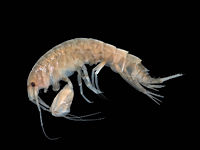Portal:Crustaceans
Portal:Crustaceans
 Crustaceans are a group of arthropods that are a part of the subphylum Crustacea (/krəˈsteɪʃə/), a large, diverse group of mainly aquatic arthropods including decapods (shrimps, prawns, crabs, lobsters and crayfish), seed shrimp, branchiopods, fish lice, krill, remipedes, isopods, barnacles, copepods, opossum shrimps, amphipods and mantis shrimp. The crustacean group can be treated as a subphylum under the clade Mandibulata. It is now well accepted that the hexapods (insects and entognathans) emerged deep in the Crustacean group, with the completed group referred to as Pancrustacea. The three classes Cephalocarida, Branchiopoda and Remipedia are more closely related to the hexapods than they are to any of the other crustaceans (oligostracans and multicrustaceans). The 67,000 described species range in size from Stygotantulus stocki at 0.1 mm (0.004 in), to the Japanese spider crab with a leg span of up to 3.8 m (12.5 ft) and a mass of 20 kg (44 lb). Like other arthropods, crustaceans have an exoskeleton, which they moult to grow. They are distinguished from other groups of arthropods, such as insects, myriapods and chelicerates, by the possession of biramous (two-parted) limbs, and by their larval forms, such as the nauplius stage of branchiopods and copepods. Most crustaceans are free-living aquatic animals, but some are terrestrial (e.g. woodlice, sandhoppers), some are parasitic (e.g. Rhizocephala, fish lice, tongue worms) and some are sessile (e.g. barnacles). The group has an extensive fossil record, reaching back to the Cambrian. More than 7.9 million tons of crustaceans per year are harvested by fishery or farming for human consumption, consisting mostly of shrimp and prawns. Krill and copepods are not as widely fished, but may be the animals with the greatest biomass on the planet, and form a vital part of the food chain. The scientific study of crustaceans is known as carcinology (alternatively, malacostracology, crustaceology or crustalogy), and a scientist who works in carcinology is a carcinologist. (Full article...)
Hemilepistus reaumuri is a species of woodlouse that lives in and around the deserts of North Africa and the Middle East, "the driest habitat conquered by any species of crustacean". It reaches a length of 22 mm (0.87 in) and a width of up to 12 mm (0.47 in), and has seven pairs of legs which hold its body unusually high off the ground. H. reaumuri occurs at great population densities and fills an important niche in the desert ecosystem. It feeds on plant leaves, obtains most of its water from moisture in the air and sand, and is in turn an important prey item for the scorpion Scorpio maurus. H. reaumuri is only able to survive in such arid conditions because it has developed parental care of its offspring. Adults dig burrows which are inhabited by family groups, which are recognised using pheromones. The burrows are 40–50 cm (16–20 in) deep, and the woodlice retreat to the relatively cool and moist conditions of the burrow when surface conditions are unfavourable. The territorial limit of each colony is marked with a faecal embankment.

Edward J. Miers F.Z.S. F.L.S. (1851–1930) was a British zoologist and curator of the crustacean collection at the Natural History Museum in London. He contributed to the scientific reports from the Challenger expedition of 1872–1876, and described 32 new genera and at least 260 new species and subspecies of decapod crustaceans, along with four genera and 72 new species in other orders. Miers published his Catalogue of the stalk- and sessile-eyed Crustacea of New Zealand in 1876 and revised the Plagusiinae, Hippidae, Majidae, Squillidae and Idoteidae in monographs dated 1878–1881. He also reported on the collections donated by the Admiralty from a number of voyages, including the survey of the coast of Japan by H.M.S. Sylvia (1870–1877), an expedition to view the Transit of Venus in Kerguelen and Rodrigues (1874–1875), a survey of the Galápagos Islands by H.M.S. Petrel, Novaya Zemlya by H.M.S. Isbjorn (1879), Baron Hermann-Maltzan's voyage to Gorée in 1881, and the voyages of H.M.S. Alert to Patagonia and the Strait of Magellan (1881–1882). The upheavals at his workplace and the quantity of work to be done may have taken their toll on Miers, and he was "completely prostrated with illness" for three months. Miers was still working on material from the Alert expedition, when six boxes containing the crabs from the Challenger expedition arrived, sent by John Murray. Describing these crabs would be Miers' largest taxonomic work, one which was published in 1886 as Report on the Brachyura collected by H. M. S. Challenger during the years 1873–1876 in 1886. Miers' honorarium for this work was £63 (60 guineas).  Liocarcinus marmoreus, the marbled swimming crab, is a species of crab found in the northern Atlantic Ocean and North Sea. The following are images from various crustacean-related articles on Wikipedia.
The following Wikimedia Foundation sister projects provide more on this subject:
Discover Wikipedia using portals |




















































